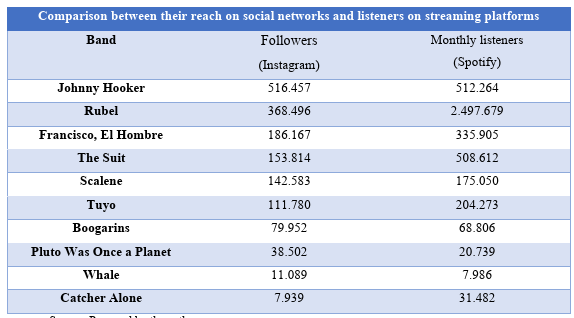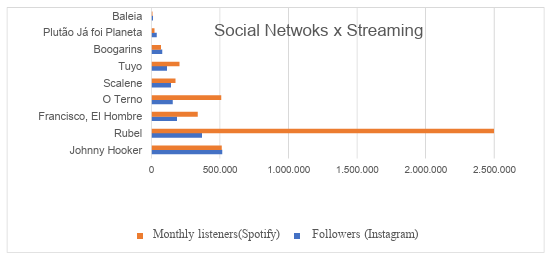THE MUSICIAN AS AN “EXECUTIVE” IN THE MARKET
REGISTRO DOI: 10.69849/revistaft/ra10202507070927
Israel Tenório Brito1
Resumo
Este artigo explora os desafios enfrentados por líderes de bandas autorais de pequeno e médio porte no Brasil ao tentarem transformar seus projetos musicais em produtos concretos e sustentáveis. A pesquisa parte do princípio de que o músico moderno precisa desenvolver habilidades empreendedoras e comunicativas para manter uma agenda constante de apresentações, valorizar sua arte e motivar sua equipe de forma estratégica. Além disso, o artigo alerta para a necessidade de formação contínua e capacitação para que músicos possam atuar de forma profissional e competitiva. Destaca-se a importância do conhecimento em gestão cultural e estratégias de mercado. Dessa forma, contribui para a profissionalização do setor musical no Brasil.
Palavras-chave: líder de banda; criatividade; projeto musical; vender arte; objetividade musical para o mercado.
Abstract
This article explores the challenges faced by leaders of small and medium-sized bands in Brazil when trying to transform their musical projects into concrete and sustainable products. The research starts from the premise that the modern musician needs to develop entrepreneurial and communication skills in order to maintain a constant schedule of performances, value their art and motivate their team in a strategic way. In addition, the article warns of the need for continuous education and training so that musicians can perform professionally and competitively. It highlights the importance of knowledge in cultural management and market strategies. In this way, it contributes to the professionalization of the music sector in Brazil.
Keywords: band leader; creativity; musical project; selling art; musical objectivity for the market.
INTRODUCTION
Leading an independent music band requires much more than artistic talent. The musician who takes on this role is often overwhelmed with tasks that go beyond the stage, such as commercial negotiations, brand building, organizing schedules and promotion strategies. This multiplicity of functions transforms them, in practice, into a creative entrepreneur. According to authors such as Idalberto Chiavenato (2005), who highlights the importance of strategic leadership in team management, and Paul Allen (2013), who discusses the professionalization of music careers, artistic success depends on the artist’s ability to manage their own business.
Furthermore, this type of leadership requires a delicate balance between creative expression and the objective demands of the market. The singer-songwriter who leads a band needs to make difficult decisions without compromising the artistic integrity of the project. Their growth in the music industry can not only guarantee profitability and financial stability, but also make a social contribution by encouraging the professionalization of the sector and inspiring other individuals with a creative profile to follow similar paths.
Methodology
The methodology adopted in this article is a literature review, which consists of selecting, analyzing and critically interpreting relevant scientific publications on the subject under study. To do this, searches were carried out in recognized databases, using specific inclusion and exclusion criteria to guarantee the quality and relevance of the sources. The research covered articles, books and other published documents, prioritizing materials of high reliability and relevance to the problem investigated. The data on the bands analyzed in Table 01 and Graph 01 was collected from the bands’ public profiles on the Spotify streaming platform and the Instagram social network. After collection, the data was organized, compared and discussed systematically, allowing us to identify gaps, convergences and divergences in the literature.
AFEW WORDS ON CURRENT HISTORY AND MODERN CONTEXTUALIZATION
Medium-sized bands in Brazil and the United States, such as Francisco el Hombre, BaianaSystem and Snarky Puppy, have managed to create sustainable career models without renouncing their artistic identity. These groups have invested heavily in organizational structure, digital marketing and strategic planning to ensure a constant presence in the market, maintaining active annual schedules and building loyal audiences.
To achieve such results, it is essential to understand that entrepreneurship in music requires a clear separation between dedication to art and commitment to management. Delegating functions such as scheduling shows, managing social media, merchandising and finances is essential. The leader needs to distribute their time between musical creation and medium and long-term planning. It is also necessary to take care of emotional and physical balance, maintaining healthy boundaries between personal life and intense dedication to the project.
Authors such as Richard Florida (2002), when addressing the rise of the creative class, reinforce the idea that professionals who work with art and innovation must possess not only artistic sensibility, but also entrepreneurial skills. In this context, the musician becomes an economic agent, capable of moving resources, generating jobs and contributing to the cultural development of their community.
According to Elizabeth Currid (2007), the creative economy thrives in environments where symbolic production is combined with professional structure and social capital. This means that independent musicians need to be part of collaborative networks and have access to public or private policies that encourage the circulation and commercialization of their artistic production.
In addition, authors such as Gustavo Mini (2014) point out that strategic planning is one of the most important tools for independent artists, as it allows them to constantly analyze the market scenario and adjust their actions with a focus on career longevity. Without planning, even the most talented artistic projects run the risk of not surviving the demands of the market.
THE USE OF STREAMING AND CONCERT SALES
Digital platforms such as Spotify, Deezer and Apple Music offer artists the possibility of distributing their music globally. However, for many independent musicians, the financial return from streaming is still limited. For this reason, the sale of physical products during concerts remains an important source of income. Creative strategies such as personalized USB sticks, exclusive LPs and limited edition CDs strengthen the bond with fans and help fund the continuity of the project.
Combining the digital environment with face-to-face actions generates authentic engagement. Artists who bet on visual storytelling, stage presentations and a well-defined brand identity have a better chance of turning casual listeners into committed fans, who not only consume but also promote the band on their networks.
These bands have invested in cultural circuits all over Brazil, visiting capitals such as São Paulo, Rio de Janeiro, Salvador, Recife, Rio Grande do Norte, Belo Horizonte, Porto Alegre and university cities such as Campinas, Juiz de Fora and Florianópolis. Many organize their own tours or enter into partnerships with cultural venues and independent festivals, maximizing their territorial reach and reducing production costs. This logistical planning is one of the strategic roles of executive music production, which aims to align the calendar, budgets and regional promotional campaigns.
In addition to ticket sales, artists have made a name for themselves with engagement actions that enhance the audience experience: meet & greets, autograph sessions, sales of customized products and even monthly subscriptions to exclusive content. These elements strengthen the community around the band and increase their source of recurring income, which guarantees greater budget predictability throughout the year.
DATA AND ANALYSIS OF CURRENT AUTHOR BANDS
Below we list data collected from the official Instagram and Spotify profiles of the bands Tuyo, Scalene, Apanhador Só, Boogarins, Rubel, Francisco, el Hombre, O Terno, Plutão Já Foi Planeta, Baleia and Johnny Hooker.
See table 1.

Source: Prepared by the author.
Now take a look at graph 1.

Source: Prepared by the author.
Bands like Rubel, O Terno, Tuyo and Boogarins accumulate thousands of monthly listeners on Spotify and have a solid presence on Deezer and Apple Music. Despite their online visibility, these artists report that streaming revenue often only covers a fraction of their operating costs, such as rehearsals, production and tour logistics. For this reason, face-to-face events remain fundamental for financial sustainability, with ticket sales ranging from 300 to 2,500 per show, depending on the city and the type of event.
These bands are examples of artistic overcoming combined with professionalization. Most of them started out independently and had to adapt their working models to the market, investing in planning, visual identity, executive production and communication. The loyalty of an audience that values originality and collective effort was a decisive factor in consolidating their careers.
ANALYSIS AND CONSIDERATIONS
The bands listed demonstrate that, even without the backing of major record labels, it is possible to achieve success and maintain a sustainable career through effective executive production strategies. Elements such as a consistent musical identity, an active digital presence and engagement with the public are fundamental.
Professionalization involves not only artistic quality, but also the ability to manage one’s career as a business. This includes tour planning, financial management, marketing and fan relations. Bands that manage to balance these aspects tend to build a solid base of followers and guarantee a constant presence at events and festivals.
In addition, the diversification of income sources, such as merchandising sales, crowdfunding and music licensing, contributes to the financial stability of projects. The ability to adapt to market changes and new technologies is also essential for longevity in the music industry.
CONCLUSION
Musicians who choose to work as executive producers for their own bands face a double challenge: artistic and business leadership. This professional’s tasks include planning releases, scheduling shows, negotiating with venues, team management, financial control, brand promotion and maintaining a public image.
In addition to these duties, the executive producer is also responsible for drawing up recording budgets, seeking sponsorship and public notices, organizing regional and national tours, drafting contracts and managing digital and physical performance reports. They must also master digital marketing tools, understand reach and conversion metrics, manage copyright and maintain a sustainable cash flow. This professional needs to combine strategic vision and artistic sensitivity.
On the other hand, the challenges are considerable: the accumulation of functions can lead to physical and emotional exhaustion, especially when the artist doesn’ t have a structured team. Investments in recordings, rehearsals, video clips, promotion and tour logistics require rigorous financial planning. Difficulties in signing contracts, rescheduling events or dealing with the instability of the Brazilian cultural market are recurring obstacles.
Despite this, the benefits of executive production are significant. The musicianproducer acquires greater autonomy, strengthens their artistic identity, expands their fan base and has greater control over the direction of their own career. In addition, they are able to transform their art into a sustainable enterprise, capable of generating cultural, social and economic impact. This hybrid profile reveals a new generation of artists prepared for the stage and behind the scenes of the music market.
REFERENCES
ALLEN, Paul. (2013). Artist Management for the Music Business. New York: Routledge.
CHIAVENATO, Idalberto. (2005). Gestão de Pessoas: o novo papel dos recursos humanos nas organizações. Rio de Janeiro: Elsevier.
CURRID, Elizabeth. (2007). The Warhol Economy: How Fashion, Art, and Music Drive New York City. Princeton: Princeton University Press.
FLORIDA, Richard. (2002). The Rise of the Creative Class. New York: Basic Books.
FRANÇA, Juliana. (2020). Marketing para Músicos. Porto Alegre: Editora Sulina.
KOTLER, Philip; Keller, Kevin Lane. (2012). Administração de Marketing. São Paulo: Pearson.
MINI, Gustavo. (2014). A estratégia do olho: como músicos independentes devem planejar sua carreira. Porto Alegre: Artes & Ofícios.
PASSOS, João. (2019). Música e Empreendedorismo: estratégias para artistas independentes. São Paulo: Appris.
NEWSROOM. Spotify Charts e dados de redes sociais (2024). Páginas oficiais das bandas citadas. https://newsroom.spotify.com/2024–12–04/top–songs–artists–podcasts–audiobooksalbums–trends–2024/ Accessed in June 2025.
1Israel Tenório Brito é músico, compositor, vocalista e instrumentista brasileiro. Bacharel em Ciências Sociais (Ciências Políticas e Sociologia), bacharel em Letras Inglês e Português e pós graduado em Língua Inglesa.
